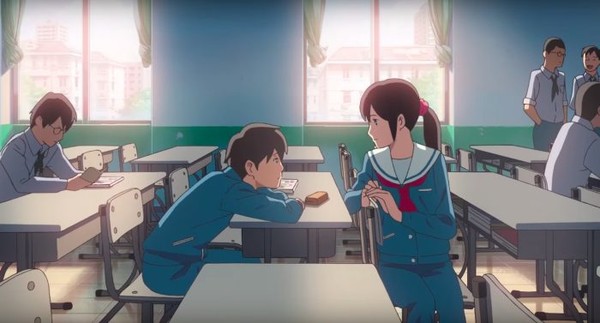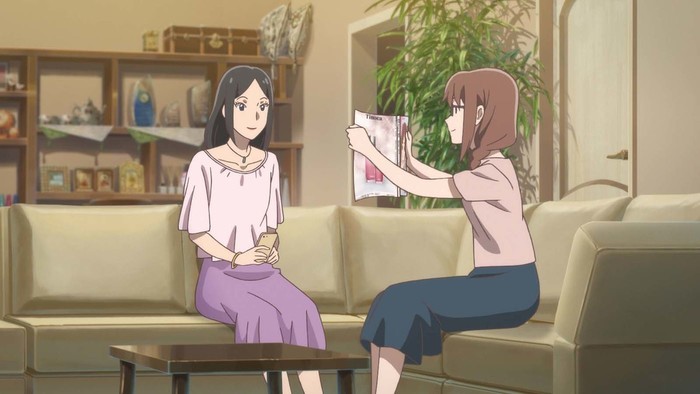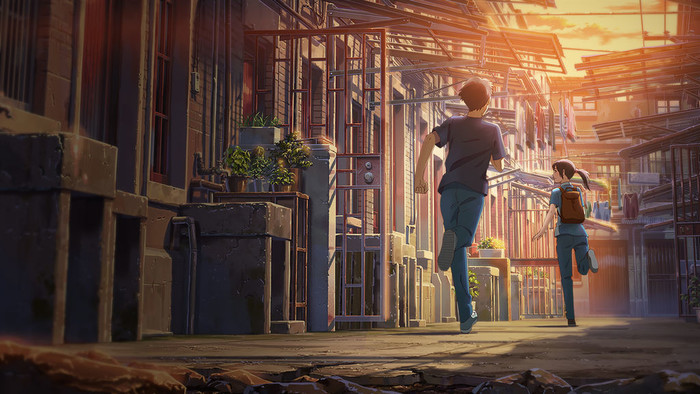Interview: Flavors of Youth Producer Noritaka Kawaguchi and Director Yoshitaka Takeuchi
by Zac Bertschy,Both a tribute to the beauty of China and a feature-length homage to Makoto Shinkai's classic 5 Centimeters Per Second, CoMix Wave and Haoliners' international coproduction Flavors of Youth represents something significant for just about everyone involved. For Makoto Shinkai's production house CoMix Wave, the film was a major international collaboration; for Li Haoling, the CEO of Chinese animation studio Haoliners, the film represented an opportunity for him to both direct a segment AND work with a team he'd long respected. The film itself is a gorgeous triptych of gentle, nostalgic, sometimes romantic stories set against the backdrop of China, from glittering cityscapes to the rustic countryside – it's available on Netflix as of this writing. We had the chance to speak with CoMix Wave producer Noritaka Kawaguchi and ‘A Small Fashion Show’ segment director Yoshitaka Takeuchi shortly after the film's premiere at Anime Expo this summer for some insight into what it took to put this project together, and the pressure of working in the house of Shinkai.

ANN: So how did this project come together at first?
NORITAKA KAWAGUCHI, Producer: Five, six years ago, artists from Haoliners in China – who were big fans of Makoto Shinkai - came over to see us many times. And then, along the way China became richer than Japan. <Laughs> So that's when they started offering to finance and put the project together. We only have one production line for Makoto Shinkai, so once we completed your name., we had a one year gap for production, fortunately. So I thought it was meant to be, to accept this project, because it's a perfect fit for our production schedule.
And Li Haoling (CEO of Chinese animation studio Haoliners) himself was a huge fan of 5 Centimeters Per Second, right? He was a big fan?
KAWAGUCHI: Yes.
I was wondering if you could talk about that, about CoMix Wave's relationship with Haoliners, and exactly how you interfaced on this film.
KAWAGUCHI: They brought the idea in and we accepted it.
With that in mind, what was your first thought when they described the premise of it, and were you eager to revisit something in a similar style to Five Centimeters Per Second?
KAWAGUCHI: I actually had a thought even before they approached us - if we take the city of Shanghai and bring in our production team, Team Shinkai. I thought that would be something fantastic. So that notion was there before this project came up.
Was it the particular beauty of cities in China itself that inspired the idea of basically doing 5 Centimeters Per Second in China? Each segment takes place in a different city - Beijing, Shanghai. So I was wondering if the beauty of those cities themselves inspired this film.
KAWAGUCHI: Actually two Chinese directors chose their hometown. So of course they care about their hometown, that kind of reflected on the screen. Of course he's (referring to Takeuchi) the only Japanese director, but he himself chose Guangzhou for his episode.

Tell us a little bit about your episode, what about that story specifically spoke to you?
YOSHITAKA TAKEUCHI, Director: I wanted to focus on the relationship between people. I created this story based on two sisters, while this project itself was born between the nations of Japan and China. So I wanted to depict how relationships change.
There are a lot of really lavishly—especially in the first segment—food is very lavishly animated. Was that always going to be a focus for this film?
TAKEUCHI: That was actually the director's—Xiaoxing—opinion and request to make it lively and beautiful as possible. Actually, that specific scene was drawn by the ex-Ghibli artists.
You could tell, you could tell. It looks good. What are some of the specific challenges working on an anthology film like this? For you as a producer, is it a lot more challenging to wrangle all these different artists across three segments? Did you relish that challenge?
KAWAGUCHI: I was not even actually worrying about that, because the original plan was three individual short films, released individually. But each episode turned out pretty good, and I got the idea - “wait a second, if we put it all together and make it a little bit longer than sixty minutes, then maybe it's suitable for the theatre.” That's how good it was. So the structure of this anthology film is actually calculated carefully and intentionally put it that way.
For working on your segment, how closely did you work with the inbetween staff? What did you handle in Japan at CoMix Wave and what did Haoliners wind up handling? How did you bridge that gap as director?
TAKEUCHI: Each episode has a different production style, and our involvement is different in each one. In terms of my episode, everything was done in Japan because I'm based in Japan, the production was in Japan. 100% made in Japan. But the first episode was actually—the team there handled it up to the script, and then they handed it over to Japan. And the last episode, the director himself did the storyboards and then passed it on to CoMix Wave Films in Japan. Of course the director would continue to give direction afterwards, they stay on, but that's how we split the work between China and Japan. That I think is part of the reason why we were successful, because we know clearly what we do and what they do. So there was no confusion.

With that in mind, does that seem like a fruitful working relationship? Would you be interested in doing that again?
KAWAGUCHI: I think it's a successful experiment, and I'm glad we've done it. Now I'm getting a lot of offers. However, again, we only have one production line, so god only knows what's going to happen in the future.
When someone like that comes to you and wants CoMix Wave to produce something, are they specifically looking for the Shinkai look? Is that what they want you to provide?
KAWAGUCHI: Yeah, they're looking for Shinkai style.
How does Shinkai feel about that?
KAWAGUCHI: He always concentrates 100% on his next film. So he doesn't care at all what we're doing while the production has a gap. That's what I like about him.
So this film must've been maybe less stressful for you to make than working directly with Shinkai.
KAWAGUCHI: Different stresses. Both are stressful. Shinkai has a specific view in his head, and he doesn't allow anything else. In a way, it's difficult, because we have to reflect exactly what he's thinking. But no matter which type of project we're working on, we always overspend during the production because we try to make it better and better.
So did this one go far over budget?
KAWAGUCHI: Of course. <Laughter>
Well I think it worked out in the end, it looks great. So for Mr. Takeuchi, what did you find the most challenging aspect of bringing that particular story to life?
TAKEUCHI: So actually, I've been working with Shinkai for more than ten years. So when it comes to the visuals, if I'm just on autopilot, it'll look like Shinkai. However, I'm the director this time, so of course I wanted to reflect my vision, not Shinkai's. So that's why I try to put a little bit more of myself in there, and try not to do the same thing that Shinkai does. I try to introduce whatever I'm more interested in, more personal stuff into the story.

So you were sort of walking a line, expressing yourself while working within this expected style?
TAKEUCHI: You're basically right. There's no way I can shake off all the Shinkai on a project like this after working with him for more than ten years. But since it's my film, I'm the director, so I tried to express as much of myself as I can with color, style, sound, and dialogue. If it looked too much like a Shinkai film, I'd feel disappointed.
In your mind, who is the target audience for this movie?
KAWAGUCHI: Chinese audience. A young Chinese audience.
Are you at all nervous about the reception it might get in China?
KAWAGUCHI: I actually got some confidence when I was watching the audience today (at the Anime Expo 2018 premiere) - I became much more confident.

They loved it at the premiere!
KAWAGUCHI: Especially this bunch of Chinese guys who came up to ask questions afterwards. That's when I was sure that “okay, this could become a big hit in China.”
That's really great. In your heart, say someone comes to CoMix Wave with an investment for a film and says “we don't want this to look like a Makoto Shinkai film.” Would you relish that opportunity? Especially for you, Mr. Takeuchi, if they came and said “okay, we just want your style, we do not want the Shinkai style, but we want that CoMix Wave quality.” Is that something you would leap at?
KAWAGUCHI: Again, we only have one production line. So if we had the production capability, we would do it. But most importantly, whoever comes in, the director comes in, and if he's real… if he's speaking from the heart, that's what really matters. Of course all the other things matter, but most importantly that the director, or whoever's coming to you, is speaking from the heart.
TAKEUCHI: We're always open to new opportunities. However, again, the most important thing is if it's real or not. Meaning the project comes from their heart. They won't budge at all, even if you brought in millions and millions of dollars, if your project doesn't move them at all. That's what moves us – the staff at CoMix Wave get excited to work for Makoto Shinkai because he's real, right? What he makes comes from the heart. So actually, the most important thing to move us, when it comes to decisions like that, is if there is love in the project or not.
Our thanks to Netflix, Noritaka Kawaguchi and Yoshitaka Takeuchi for the opportunity.
discuss this in the forum (2 posts) |
this article has been modified since it was originally posted; see change history